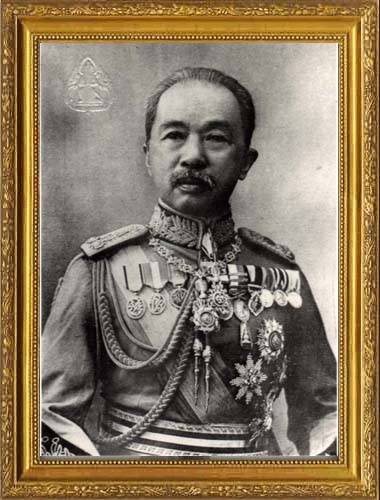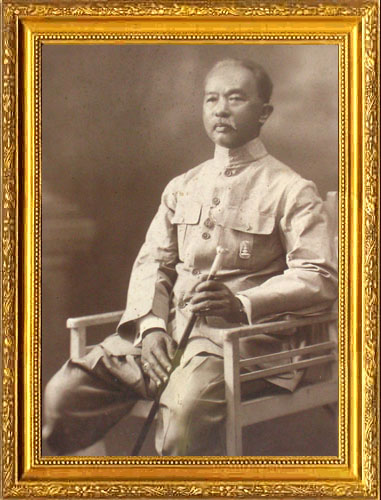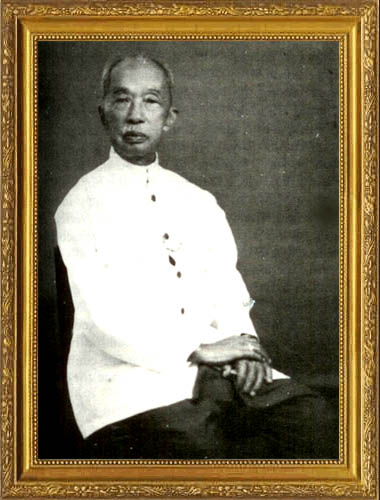 The Royal Thai Government declared December 1 as
" Damrong Rajanupab Day "
to commemorate the "Father of Thai History". His residence, Varadis Palace,
is a lasting memorial to his life and achievements :
-------------------------------------------------------------------------------- The Royal Thai Government declared December 1 as
" Damrong Rajanupab Day "
to commemorate the "Father of Thai History". His residence, Varadis Palace,
is a lasting memorial to his life and achievements :
--------------------------------------------------------------------------------
 Tucked behind a row of unassuming shophouses on busy Lan Luang Road lies an oasis of tranquillity, a peaceful, shady compound full of mature trees that provides an unexpected respite from the hustle, bustle and heat of the endless traffic in the urban jungle outside.
Tucked behind a row of unassuming shophouses on busy Lan Luang Road lies an oasis of tranquillity, a peaceful, shady compound full of mature trees that provides an unexpected respite from the hustle, bustle and heat of the endless traffic in the urban jungle outside.
 Set amidst this lush foliage is a stately, colonial-style mansion, sufficiently large to inspire interest and awe, yet modest enough to be warm and unimposing. This is Varadis Palace, former residence of His Royal Highness Prince Damrong Rajanupab, a remarkable man who devoted his life to serving kings and country.
Set amidst this lush foliage is a stately, colonial-style mansion, sufficiently large to inspire interest and awe, yet modest enough to be warm and unimposing. This is Varadis Palace, former residence of His Royal Highness Prince Damrong Rajanupab, a remarkable man who devoted his life to serving kings and country.
 The land on which the palace itself stands once belonged to his mother, Chao Chom Marnda Chum. In the late 19th century this was still a sleepy suburban area. It was linked to the city centre which then comprised Rattanakosin Island and the Grand Palace compound by a tiny road with canals flowing on either side. A bridge provided access to the property.
ี
The land on which the palace itself stands once belonged to his mother, Chao Chom Marnda Chum. In the late 19th century this was still a sleepy suburban area. It was linked to the city centre which then comprised Rattanakosin Island and the Grand Palace compound by a tiny road with canals flowing on either side. A bridge provided access to the property.
ี
 As a gift in appreciation of Prince Damrong's success in setting up the thesaphiban system (see accompanying story), King Chulalongkorn presented him with more land adjacent to the plot prince had inherited from his mother. The palace was designed by Karl Dohring, the German architect who was also responsible for Bang Khun Prom Palace (now a museum) and Ban Puen Palace in Phetchaburi. The cost of erecting the structure was borne by King Vajiravudh, and by Queen Sri Bajarindra of the fifth reign.
As a gift in appreciation of Prince Damrong's success in setting up the thesaphiban system (see accompanying story), King Chulalongkorn presented him with more land adjacent to the plot prince had inherited from his mother. The palace was designed by Karl Dohring, the German architect who was also responsible for Bang Khun Prom Palace (now a museum) and Ban Puen Palace in Phetchaburi. The cost of erecting the structure was borne by King Vajiravudh, and by Queen Sri Bajarindra of the fifth reign.
 Like many stately residences of the 1880s, the palace was built in a mixture of European styles with architectural features ranging from Renaissance and baroque to art nouveau and art deco. The design was adapted to take advantage of seasonal breezes and shield the building from monsoonal rains. Other Typical features of these so-called colonial houses were wide verandahs on the ground floor and large rooms on either side of the first floor house with louvred, floor-to-ceiling windows and roofs with overhanging eaves. The rooms for everyday use were usually lined up along the centre of the house. Bedrooms usually faced south so as to benefit from the prevailing southeasterly winds.
Like many stately residences of the 1880s, the palace was built in a mixture of European styles with architectural features ranging from Renaissance and baroque to art nouveau and art deco. The design was adapted to take advantage of seasonal breezes and shield the building from monsoonal rains. Other Typical features of these so-called colonial houses were wide verandahs on the ground floor and large rooms on either side of the first floor house with louvred, floor-to-ceiling windows and roofs with overhanging eaves. The rooms for everyday use were usually lined up along the centre of the house. Bedrooms usually faced south so as to benefit from the prevailing southeasterly winds.
 A long pond was dug to connect the compound with the canal outside and help drain off excess rainwater. The palace was completed in 1911, and Prince Damrong lived there until his death in 1943. A long pond was dug to connect the compound with the canal outside and help drain off excess rainwater. The palace was completed in 1911, and Prince Damrong lived there until his death in 1943.
 The two-storey building faces north onto Lan Luang Road. The entrance hall is decorated in the baroque style, with ceramic-and-gold art deco lighting fixtures and, in a prominent position on one wall, Prince Damrong's personal crest a kneeling angel, representing heavenly protection of the good and pure of heart. A staircase winds upwards, lined with walking sticks from the prince's large collection. The two-storey building faces north onto Lan Luang Road. The entrance hall is decorated in the baroque style, with ceramic-and-gold art deco lighting fixtures and, in a prominent position on one wall, Prince Damrong's personal crest a kneeling angel, representing heavenly protection of the good and pure of heart. A staircase winds upwards, lined with walking sticks from the prince's large collection.
 The hall leads straight into a formal reception room done in the traditional Chinese style with marble floor and furniture inlaid with mother of pearl a gift from King Chulalongkorn. Apparently the prince decided on Chinese d?cor partly to offset the influence of Indian culture on everything from the Thai language to Buddhism and party to inspire Thais to come up with unique designs of their own . Statues of three Chinese deities of prosperity, Hok,Lok and Siew, stand against a lacquered folding screen inlaid with mother-of-pearl.
The hall leads straight into a formal reception room done in the traditional Chinese style with marble floor and furniture inlaid with mother of pearl a gift from King Chulalongkorn. Apparently the prince decided on Chinese d?cor partly to offset the influence of Indian culture on everything from the Thai language to Buddhism and party to inspire Thais to come up with unique designs of their own . Statues of three Chinese deities of prosperity, Hok,Lok and Siew, stand against a lacquered folding screen inlaid with mother-of-pearl.
 At the front of the house is a long verandah lined with photographs showing the prince at various official functions. Some give intriguing insights into historical events. One , for example, shows King Chulalongkorn with members of the royal family and high-ranking government officials; it was taken just after the monarch recovered from a serious bout of ill health. In another photograph, taken in Russia in 1891, the prince is standing with the Csaravich, later to become Csar Nicolas II.
At the front of the house is a long verandah lined with photographs showing the prince at various official functions. Some give intriguing insights into historical events. One , for example, shows King Chulalongkorn with members of the royal family and high-ranking government officials; it was taken just after the monarch recovered from a serious bout of ill health. In another photograph, taken in Russia in 1891, the prince is standing with the Csaravich, later to become Csar Nicolas II.
 Overlooking the front lawn is the study, a term which the prince preferred since he did not believe in "entertaining" guests as such, considering such visits more as an opportunity for intellectual exchange. The room contains an eclectic mix of cultures including a replica of La Pieta, a monk's pulpit, and a miniature chess set from Ayutthaya.
Overlooking the front lawn is the study, a term which the prince preferred since he did not believe in "entertaining" guests as such, considering such visits more as an opportunity for intellectual exchange. The room contains an eclectic mix of cultures including a replica of La Pieta, a monk's pulpit, and a miniature chess set from Ayutthaya.
 The study connect with the formal dining room, with its long Queen Anne dining table and two sideboards displaying a plethora of art nouveau objects, all the rage in the late 19th and early 20th centuries. This room was only used for formal Western-style dinners for royal guests including King Vajiravudh (Rama VI) and King Prajadhipok (Rama VII), and for training recipients of royal scholarships in Western ways before the students set off on their adventures in foreign lands.
The study connect with the formal dining room, with its long Queen Anne dining table and two sideboards displaying a plethora of art nouveau objects, all the rage in the late 19th and early 20th centuries. This room was only used for formal Western-style dinners for royal guests including King Vajiravudh (Rama VI) and King Prajadhipok (Rama VII), and for training recipients of royal scholarships in Western ways before the students set off on their adventures in foreign lands.
 The dining room leads out back to a wide verandah with a black-and-white chequered marble floor. This was the prince's favourite place in the house. Here he could relax in Thai-style comfort, enjoying casual dinners with his sons and daughters, chatting amicably with acquaintances about his experiences while travelling with the king upcountry or holding forth on why he believed the elected village headmen to be the heart of local administration. Upstairs, just off the landing, is the writing room, decorated in Victorian style, with an antique wooden desk standing by the window to take advantage of the natural light. The wooden floor is scattered with Persian carpets. Here can be seen a number of framed quotes by the prince, many on what he considered the essence of being a good citizen.
The dining room leads out back to a wide verandah with a black-and-white chequered marble floor. This was the prince's favourite place in the house. Here he could relax in Thai-style comfort, enjoying casual dinners with his sons and daughters, chatting amicably with acquaintances about his experiences while travelling with the king upcountry or holding forth on why he believed the elected village headmen to be the heart of local administration. Upstairs, just off the landing, is the writing room, decorated in Victorian style, with an antique wooden desk standing by the window to take advantage of the natural light. The wooden floor is scattered with Persian carpets. Here can be seen a number of framed quotes by the prince, many on what he considered the essence of being a good citizen.
 For instance: "To help develop the country towards prosperity, you need to start with Thai people learning how to love their nation, being sincere with each other, and learning about history. If you are not aware of who you are, then how can you love your country?"
For instance: "To help develop the country towards prosperity, you need to start with Thai people learning how to love their nation, being sincere with each other, and learning about history. If you are not aware of who you are, then how can you love your country?"
 A Hall of Fame displays photos of various notable members of the Diskul family. This leads into the prince's private bedroom and dressing room which faces north. Here are displayed outfits he wore as a child as well as his Royal Guard uniform.
A Hall of Fame displays photos of various notable members of the Diskul family. This leads into the prince's private bedroom and dressing room which faces north. Here are displayed outfits he wore as a child as well as his Royal Guard uniform.
 The upstairs hall was probably the most multi-functional part of the residence. It was here that he welcomed close acquaintances on a more informal basis, and it was also here that he breathed his last
The upstairs hall was probably the most multi-functional part of the residence. It was here that he welcomed close acquaintances on a more informal basis, and it was also here that he breathed his last
 The most important room in the palace is the Relics, or Ancestors Room, which, apart from Buddha images, contains relics of monarchs from the first, second, fourth and fifth reigns, and of Crown Prince Vajirunhis, a son of King Rama V. Every day the prince would visit this room to pay respect to his forebears, a practice which his descendants continue to this day. Relics of the prince himself were subsequently added to this august collection.
The most important room in the palace is the Relics, or Ancestors Room, which, apart from Buddha images, contains relics of monarchs from the first, second, fourth and fifth reigns, and of Crown Prince Vajirunhis, a son of King Rama V. Every day the prince would visit this room to pay respect to his forebears, a practice which his descendants continue to this day. Relics of the prince himself were subsequently added to this august collection.
 Also upstairs is a unique structure, not unlike a cage, encased in a fine wire mesh. This was what the prince called his "reading room".
Also upstairs is a unique structure, not unlike a cage, encased in a fine wire mesh. This was what the prince called his "reading room".
 "He once said that one works during the day and charges one's batteries at night," explained his grandson, M.R. Sangkadis Diskul, former Ambassador to Malaysia, Switzerland and the Vatican. "To charge his batteries, my grandfather read and read and read."
"He once said that one works during the day and charges one's batteries at night," explained his grandson, M.R. Sangkadis Diskul, former Ambassador to Malaysia, Switzerland and the Vatican. "To charge his batteries, my grandfather read and read and read."
 Smiling M.R. Sangkadis pointed at the strange looking contraption which allowed the prince to carry on reading late into the night without having to contend with bothersome mosquitoes.
Smiling M.R. Sangkadis pointed at the strange looking contraption which allowed the prince to carry on reading late into the night without having to contend with bothersome mosquitoes.
 Next door to the palace, which is now a private museum, is a modern building housing the Damrong Rajanupab Library. Here are stored the prince's extensive collection of books and personal writings. Apart from his initiatives and archaeology, these books are his most valuable legacy to the Thai nation.
Next door to the palace, which is now a private museum, is a modern building housing the Damrong Rajanupab Library. Here are stored the prince's extensive collection of books and personal writings. Apart from his initiatives and archaeology, these books are his most valuable legacy to the Thai nation.
 The palace and adjacent library offer a fascinating insight into one of the most memorable members of the Chakri dynasty, a man who daily mixed with civil-service mandarins, heads of state and foreign dignitaries yet who, at home with his family, lived a simple life. An inkling of his personal philosophy can be gleaned from a passage he penned:
The palace and adjacent library offer a fascinating insight into one of the most memorable members of the Chakri dynasty, a man who daily mixed with civil-service mandarins, heads of state and foreign dignitaries yet who, at home with his family, lived a simple life. An inkling of his personal philosophy can be gleaned from a passage he penned:
 "Home is where you enjoy the peace and happiness in your life. You spend more time in your home than anywhere else, so it is natural that you take care of your house, continually contributing to its added propitiousness. Only then will the household achieve true happiness and prosperity, which should be our ultimate desire. A good person can only devote himself to others and the good of the country if he has been able to organise his own home in an orderly manner."
"Home is where you enjoy the peace and happiness in your life. You spend more time in your home than anywhere else, so it is natural that you take care of your house, continually contributing to its added propitiousness. Only then will the household achieve true happiness and prosperity, which should be our ultimate desire. A good person can only devote himself to others and the good of the country if he has been able to organise his own home in an orderly manner."
 The Varadis Palace completed its project of final renovation in 1996 with new face-lift under the supervision of the late M.R. Sangkadis and his only son M.L.Panadda Diskul , Vice Governor of Pathum Thani Province , the present owner.
The Varadis Palace completed its project of final renovation in 1996 with new face-lift under the supervision of the late M.R. Sangkadis and his only son M.L.Panadda Diskul , Vice Governor of Pathum Thani Province , the present owner.
|
|
|
|












